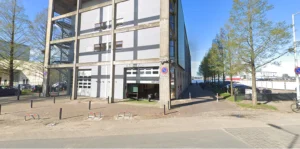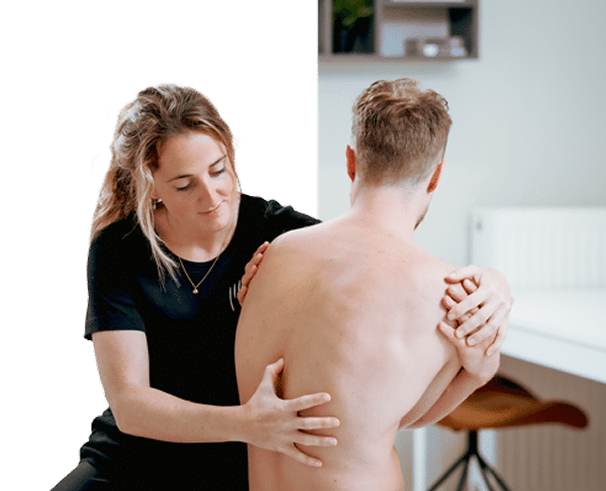What are chest complaints
Chest complaints are discomforts in and around the chest area. The pain can originate from the chest muscles, the upper back, rib joints, or connective tissue at the front. Sometimes it feels like a tightness in the chest that increases when twisting or stretching. The pain can remain local or radiate to the shoulder, upper arm, or back and then feel like pain in both the chest and back. Complaints can be related to breathing, posture, and muscle tension.
Symptoms of chest complaints
- Chest pain when moving, deep breathing, or coughing.
- Pain in the chest and armpit or at the front when pressing on the ribs.
- Stiffness between the shoulder blades with pain in the upper back and chest.
- Itching on the chest or under the breast due to skin irritation or friction.
- Red spots on the chest or small red dots due to skin reactions.
- A lump or small bump on the chest that can be tender to the touch.
Do you recognize these signals? Have your complaints assessed in time. Early intervention accelerates recovery.
Causes and considerations
Prolonged sitting, little variation, and high muscle tension can irritate the chest muscles and rib joints. Rapid progression with push and pull movements in the gym or a sudden twist can irritate a rib or chest muscle. Pain under the right breast or on the left side can fit with tendon and rib issues but sometimes requires medical evaluation if persistent. Complaints such as chest pain in women, pain in the left breast in women, or chest tightness with shortness of breath should always be assessed by a doctor. Questions about breast gland tissue, milk glands, and lymph nodes in the chest or a lump in the breast require medical evaluation. Tests such as breast checks or punctures are arranged through a doctor. In oncological care, such as radiation side effects or treatment aftercare, we help with mobility, scar comfort, and strength recovery. Questions about cosmetic issues, such as breast augmentation or lift costs, belong with a plastic surgeon and are outside physiotherapy.
What you can do yourself
- Change posture every half hour and consciously relax the shoulders.
- Breathe out calmly and feel the ribs drop to reduce tension.
- Use heat for stiffness and then move lightly with short walking moments.
- Temporarily reduce push and pull load in sport and focus on technique over weight.
- Pay attention to clothing and sports bras to reduce friction and skin pressure.
- If the pain increases or fever or unexplained swelling occurs, contact your doctor.
Exercises that help
- Side rib breathing Place a hand on the side of the chest. Inhale into the hand and exhale calmly. Ten breathing cycles per side.
- Chest opening Stand in a doorway. Elbows on the frame. Step slightly forward until a mild stretch at the front. Exhale and relax. Ten repetitions.
- Upper back rotation Sit upright. Hands in front of the chest. Slowly rotate left and right within a comfortable range. Ten each side.
- Scapula activation Lightly pull shoulder blades down and together without forcing. Hold for three counts. Ten repetitions.
Keep the pace calm and continue breathing. Mild soreness that fades within a day is acceptable. Increased pain the next day means the stimulus was too strong.
Examination and treatment at De Fysio Man
We start with an intake and a clear analysis of your load. We assess posture, breathing, and movement patterns. We test rib and spine mobility, as well as strength and coordination of chest, shoulder blade, and trunk muscles. This allows us to identify what triggers your chest complaints and which adjustments bring immediate relief.
A treatment plan usually includes:
- Targeted exercise therapy for mobility, strength, and coordination of chest and upper back.
- Breathing and tension regulation to reduce chest pressure.
- Mobilizations of ribs and spine and soft tissue techniques where needed.
- Technique advice for work and sport with clear pain limits.
- Home program with measurable milestones so you remain in control.
Skin and soft tissues around the chest
Itching on the chest, under the breast, red spots, and small red dots often fit with skin irritation, friction, or allergy. A lump in the chest, breast lump, or bump on the chest requires medical evaluation. If chest lymph nodes feel enlarged or there is concern about breast cancer, schedule an appointment with your doctor. Can men get breast cancer? Yes, although it is less common. Early detection and timely evaluation remain important.
When immediate help is needed
- Chest pain with shortness of breath, sweating, nausea, or radiation to the arm or jaw.
- Persistent pain in the left breast in women or right chest pain with illness or fever.
- Unexplained rapidly growing swelling or blood discharge from the nipple.
- Severe trauma with lasting pain or rib deformity.
In these cases, contact your doctor or emergency services immediately.
Frequently asked questions
When should I have a lump in the breast checked
Always when a lump in the breast or chest is new, growing, or remains tender. A doctor can order imaging or a biopsy. We then support with mobility and posture.
What if I feel chest pain when twisting or stretching
This often indicates rib and muscle-related chest complaints. With breathing regulation, mobility, and targeted strength, the complaints usually decrease.
Does physiotherapy help after radiation or surgery
Yes. We work on shoulder and chest mobility, scar comfort, and safe strength build-up. This helps recovery and reduces tightness and stiffness.
Is chest and armpit pain always concerning
Often muscle tension or rib mobility plays a role. If the pain persists or you feel enlarged lymph nodes in the chest or armpit, consult your doctor.
Your next step
Do not keep living with pain, pressure, or uncertainty. With a clear diagnosis and a smart plan, you regain calm in your chest and confidence in movement and breathing.
Schedule an appointment now at De Fysio Man and work with us on a strong, free, and pain-free chest.
Share this article:


